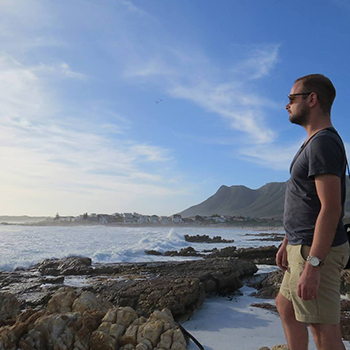
Dr Daniel Spence has been earmarked by the NRF
to become a future international leader in his field
of expertise.
Photo: Supplied
The University of the Free State (UFS) is the only university in South Africa with a P-rated History researcher. Dr Daniel Spence, a postdoctoral Research Fellow at the International Studies Group (IGS), and a member of the Vice-Chancellor’s Prestige Scholar’s Programme at the UFS, was last week awarded a National Research Foundation P-rating by the National Research Foundation (NRF). Dr Spence is the first South African historian to achieve this honour.
Leader of the pack
P-ratings are given to young researchers, usually under the age of 35, who have the potential to become leaders in their field. Researchers in this group are recognised by all, or the overwhelming majority of, reviewers as having demonstrated the potential to become future international leaders.
The rating is awarded on the basis of exceptional research performance and output from their doctoral and early postdoctoral research careers.
Other researchers from the UFS who obtained P-ratings in the past, are Prof Lodewyk Kock (1986), Prof Zakkie Pretorius (1989), and Prof Robert Schall (1991).
Extraordinary achievement lauded
“It is an extraordinary achievement. There are fewer P-ratings, than there are A-ratings,” said Prof Neil Roos, associate professor at the ISG. Prof Roos said the P-rating was seldom awarded to researchers within the field of Humanities.
As a member of the ISG, Dr Spence’s research has flourished under the guidance of Prof Ian Phimister. Much of the success of this group is due to the way it operates as an incubator for high-level research, with scholars collaborating with each other.
In addition to Dr Spence’s magnificent P-rating, the ISG currently has three C1-rated researchers (established researchers with a sustained recent record of productivity in their field) and two Y1-rated researchers (researchers 40 years old or younger, who are recognised by all reviewers as having the potential to establish themselves as future leaders in their fields).
“From the time Dr Spence wrote his doctoral thesis on the colonial history of the Royal Navy, he has expanded his field of expertise so that he can address imperial and global histories of race,” said Prof Roos.
Demonstrated research excellence
Dr Spence secured a postdoctoral Research Fellowship at the UFS to develop an African case study to augment his Asian and Caribbean research thesis into a monograph. In March 2013, Dr Spence won a three-year NRF Postdoctoral Innovation Scholarship, and learned Kiswahili ahead of archival research in Kenya and Tanzania from April to May of that year. He has conducted archival and oral research in Singapore, Malaysia, Hong Kong, Australia, Kenya, Zanzibar, the Cayman Islands, Trinidad, and the UK.
Internationally renowned
Dr Spence is the author of two monographies, the Colonial Naval culture and British imperialism, 1922-67 and A History of the Royal Navy: Empire and Imperialism. He has been invited to present papers and chair panels at over 20 international conferences, workshops and seminars.
The NRF rating system is a benchmarking system through which individuals who exemplify the highest standards of research, as well as those demonstrating strong potential as researchers, are identified by an extensive network of South African and international peer reviewers.